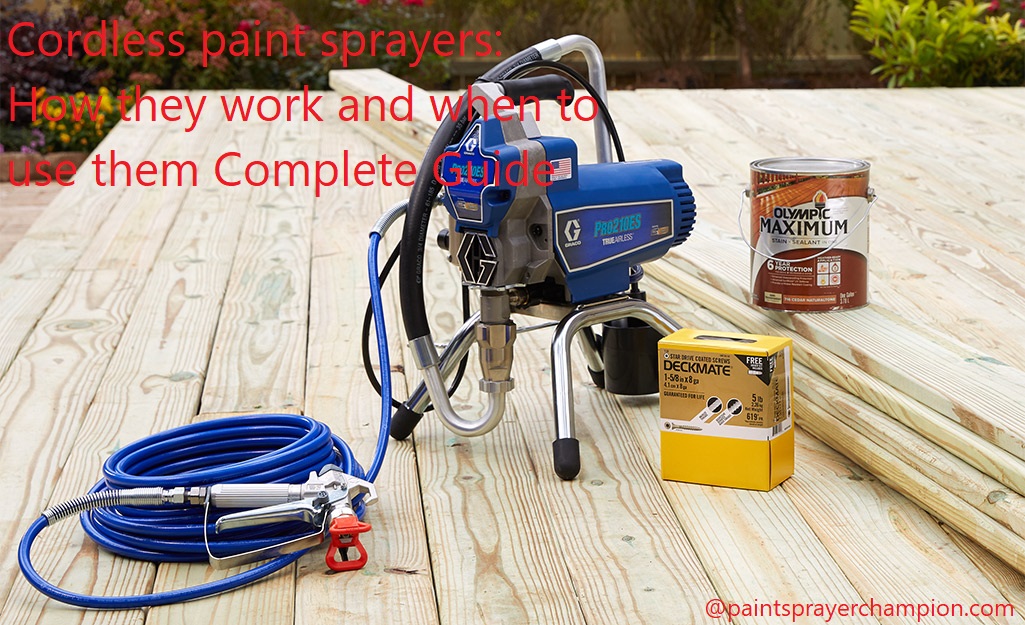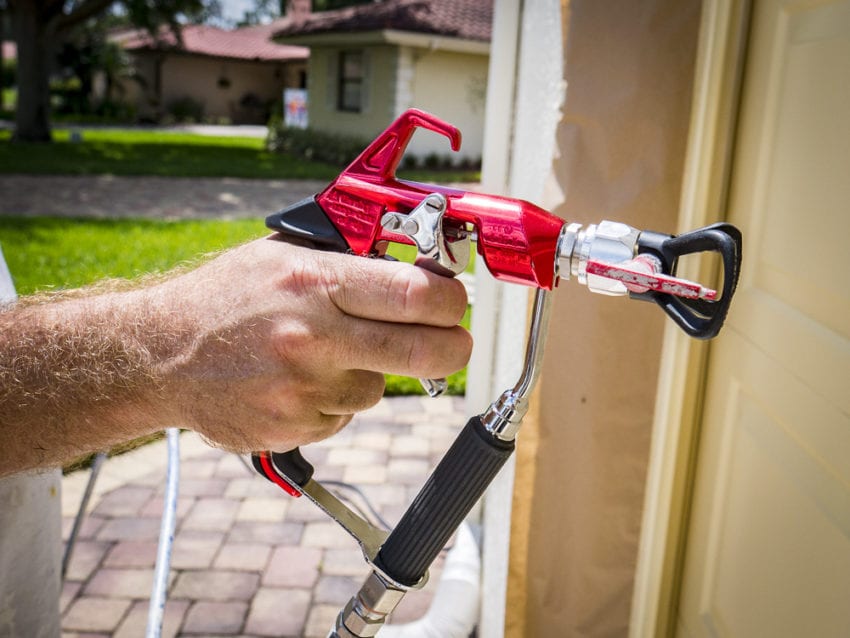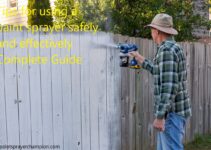Are you feeling overwhelmed when it comes to selecting the ideal paint sprayer for your project? You don’t have to anymore!
This comprehensive guide will walk you through how cordless paint sprayers work, and when you should use them. With this knowledge at hand, you will be able to choose the perfect paint sprayer for that perfect result!
Paint sprayers provide a convenient and efficient way to paint large surfaces quickly. Cordless paint sprayers are perfect for simple painting jobs on a variety of surfaces, including wood, metal, and plaster. With their portability and lack of cords or hoses, cordless paint sprayers offer more freedom of movement than traditional models.
This complete guide provides an introduction to cordless paint sprayers and their uses. It covers how they work, how to choose the right model for your needs, steps on using and maintaining them properly, as well as tips on achieving the best results with your project. From DIY home repairs to professional work tasks, you can count on cordless paint sprayers to help you finish any job with accuracy and precision every time.
Explanation of cordless paint sprayers
Cordless paint sprayers are a great addition to any painting project, providing a smoother finish with less fuss and mess. Unlike conventional paint sprayers that require an outlet and a long cord, these units are entirely self-contained. They are handy for both indoors and outdoors painting projects, such as decks, fences and siding.
Cordless paint sprayers typically operate on battery power or air compression. Rechargeable lithium-ion batteries are fast becoming the go-to choice for convenience, weight and performance. Air compression models may offer some of the same benefits but also typically require more upkeep and cleaning than battery-operated models.
Regardless of which type you choose, these cordless devices still create air pressure necessary to atomize the liquid into tiny droplets so it can be evenly sprayed onto the targeted surface. The high velocity created by this atomization allows even the most viscous liquids like latex or oil paints to flow smoothly through the nozzle with minimal fuss or mess. This makes them ideal for painting projects that require a smooth finish in less time than it would take using paint brushes or rollers alone.
Because of their versatility and mobility, cordless paint sprayers make it possible to tackle just about any surface that can benefit from this kind of application — including wood furniture, trim work or even walls in tight indoor spaces — all with greater ease than is possible with traditional roller brushes or rags. Along with their convenience factor comes less downtime during your project because there is no need to fumble around for an electrical outlet or constantly switch cords when moving from location to location; plus they allow you to easily access hard-to-reach spots without having to worry about spillage due to excess liquid pressure on manual applicators like roller brushes and sponges.

Importance of cordless paint sprayers
Cordless paint sprayers are becoming a popular choice among painters and homeowners alike. As the name implies, they are cordless, which means you don’t need an outlet to operate them. They offer a level of convenience that can’t be matched by traditional models. Corded machines tend to be bulky and unwieldy, while cordless machines can easily fit in tight spaces and provide a much greater degree of mobility.
Additionally, cordless paint sprayers are incredibly versatile; they can easily spray all types of interior and exterior surfaces with precision accuracy. This includes walls and ceilings, furniture, cabinets, doors, trim, decks and more. As for when to use them? The answer is simple: anytime you need to quickly cover a large surface area with paint or other light-duty materials such as varnish or lacquer. With the help of their powerful motor-driven pressure release technology, spraying is effortless and quick – no matter what size project you have in mind! For these reasons (and many more!), cordless paint sprayers are quickly becoming an essential tool for those who take pride in their craftsmanship.
Purpose of the guide
This guide has been designed to provide readers with a comprehensive introduction to using and maintaining cordless paint sprayers. It is intended to explain the differences between types of cordless paint sprayers, when each type may be best-suited and how to use them.
A variety of tips, tricks and learnings are included for anyone looking for a deep-dive into the world of painting projects with a cordless paint sprayer. Whether you’re hoping for long-lasting professional results or just want an easy way to get creative with some DIY projects around the house, this guide is here to give you expert advice in choosing the right type of cordless sprayer for your needs.
Additionally, proper maintenance and other helpful tips are also included for any do-it-yourselfer in mind.
How Cordless Paint Sprayers Work
Cordless paint sprayers are powered by rely batteries that are very similar to those found in other cordless tools. The paint reservoir contains enough paint to cover a small area, and this is combined with a powerful motor that turns a piston which is connected to the spray gun. As the piston moves up and down, it forces paint through the nozzle of the spray gun creating an even, fine mist over the surface of your project.
The speed at which these sprayers operate can be adjusted depending on your needs, allowing you to create an ultra-fine or thicker coat of paint. Some models also feature adjustable pressure settings and come with different tips for spraying narrow or broad lines.
It’s important to keep in mind when using cordless paint sprays that they are designed for smaller jobs. If you have larger projects requiring wide-area coverage, you’ll likely need a more powerful model like one powered by an air compressor. However, if accurate coverage along tall surfaces with awkward angles is your goal, then a cordless model could be just what you need!
Overview of the components
Cordless paint sprayers are efficient and easy to use, making them perfect for professional-level projects that require accurate, consistent coverage. This type of sprayer contains several parts that work together to evenly distribute the paint. The components include a pressure regulator, an adjustable flow control mechanism, a container for the paint, a pump and an air compressor.
The regulator is adjustable to provide the desired level of control over the amount of paint being sprayed on the surface. The flow control mechanism ensures equal distribution of the paint from all areas of the sprayer. The container stores and holds the paint until it is ready to be released into the nozzle for application on a surface. The pump helps pressurize the air compressor so that it can supply enough pressure for even application of paint. This is important as too much or too little pressure can cause run marks or pooling issues with your finished product.
Finally, an air compressor supplies oxygen which helps create enough pressure inside of the nozzle to atomize or break up your chosen medium into tiny droplets which allows it to be sprayed evenly onto your desired surface.
Process of paint spraying
The process of painting with a cordless paint sprayer is relatively simple, but the results can vary greatly depending on the distribution of the paint, air pressure and air volume.
The application of a coat of paint with a spray gun begins with creating a proper mixture of material to be sprayed. This mixture is then fed into the gun and compressed air is applied to atomize the material into very small particles. The material, now in droplet form, is forced to exit through an opening at the front end of the barrel by way of differential pressure, resulting in greater coverage per unit area.
When using a cordless sprayer for painting applications, it is important to ensure that there is proper air pressure and air volume ratio for best coverage. It’s also important to adjust the nozzle and fluid settings for different types of surfaces, as different materials require different spray techniques. For instance, large surfaces or walls may require larger droplets due to gravity which causes them to fall faster than smaller droplets produced at higher pressures and volumes. Additionally, finer mists can be produced using higher pressures when coating delicate surfaces like automotive trim or wooden furniture pieces that require more precision in application.
Advantages of cordless paint sprayers
Cordless paint sprayers are convenient to use, as they can be operated almost anywhere without having to worry about finding a power source. This makes them an ideal choice for those who prefer to work on projects outdoors or in non-traditional spaces. With a cordless paint sprayer, you can take your painting task with you wherever you go.
In addition, cordless paint sprayers provide users with excellent portability and flexibility in terms of where they do their painting projects. As such, these types of sprayers are especially well suited for DIY enthusiasts and professionals alike who want the option of being able to move from one site to another quickly and easily with their chosen equipment in tow.
Moreover, cordless models offer users the potential for improved accuracy in comparison to other models due to their reduced level of vibration and increased control over the volume of air released. Consequently, those looking for sharp accuracy within the confines of a smaller-sized area will benefit from using this type of tool.
Finally, when it comes to convenience and speed, many users report that cordless paint spray guns are able to complete most jobs much faster than alternative methods like rollers or brushes; this makes them ideal for larger project areas that require a quick turnaround time or tight deadlines.

When to Use Cordless Paint Sprayers
Cordless paint sprayers can be incredibly helpful tools for completing a range of projects. From small touch-ups to major refinishing jobs, these tools are designed to make painting easier and faster. Here’s a guide on when it’s best to use cordless paint sprayers, as well as how they work and tips for maximum efficiency.
Paint jobs that require coverage of large areas are best suited for cordless paint sprayers. However, they can also bring precision to detailed work, like cabinets and furniture refinishing. In terms of paints and finishes, the tool works well with most standard types found in hardware stores (latex, lacquer, sealer, etc.), but keep in mind that there may be certain limitations related to the type of nozzle or material used; always refer to the manual before use.
When using these tools, it is important to approach the project safely and thoughtfully – with both indoor and outdoor operations in mind – so that you can get an even coat without creating an excessive mess or unpleasant surprise by running out of battery life halfway through an important task. The proper attire should be worn (protective glasses, mask or respirator) since particles may disperse during application; additionally you should make sure that protected areas are taped off with plastic in order prepare a suitable space for job completion. When operating outdoors it is essential to have an extension cord nearby as it’s likely that at some point you will need additional power from your work plan’s generator or wall outlet.
Overall cordless paint sprayers allow users to effectively cover large amounts materials while providing extra convenience when dealing with tight spaces where cords would otherwise inhibit movement. Being armed with knowledge about proper preparation and safe operation will help ensure successful projects every time!
Interior Painting
Interior painting projects often require the use of a cordless paint sprayer, as it is more efficient and effective than using a brush or roller. These tools make quickly applying paint to properly prepped surfaces easier compared to traditional methods. They are also highly versatile and can be used on furniture, walls and ceilings alike. The only downside to using a cordless paint sprayer is that the area needs to be well-ventilated due to the fumes created while painting.
Using a cordless paint sprayer has many advantages over other painting methods:
- It provides fast and easy application, allowing you to get projects done quickly
- It provides a smoother finish due to its ability to atomize the paint
- Paint is distributed evenly across surfaces for superior coverage
- Less time and effort is needed for prep work, as there’s no need for cloths or taping
- Clean up is simple; just rinse out with water when done
To ensure best results when using a cordless sprayer, ensure that you prepare your work space properly prior to use. This includes clearing the area of any delicate items that could be damaged by adjustable air pressure levels found in some units. Aspect such as the viscosity of your product, speed setting on your machine and air compressor settings need to be taken into account with each project in order to determine best performance results. Lastly always end your project with ample clean up afterwards so that you avoid damage done by product particles left lying around inside or outside of your wheelhouse.
Exterior Painting
When dealing with exterior painting projects, cordless paint sprayers can provide a quick and efficient solution. It is important to select the proper application technique for maximum coverage, especially when tackling larger surfaces.
The wide range of available nozzles on cordless paint sprayers allows for project customization and precision painting. Indoors or outdoors, homeowners can benefit from an even coat with less mess; allowing them to finish projects faster and more efficiently. By applying an even coat of paint the job will be done in less time and hassle-free.
For exterior projects, uneven surfaces should be sprayed at a distance of nine to twelve inches away from the surface. This is commonly known as “tip back” technique which eliminates any chances of over-spraying and minimizes drips or runs while also preventing clogging problems due to high paint viscosity on deeper crevices or angled surfaces like siding corners or decorative mouldings. To get full coverage it is suggested spraying at a 45 degree angle sweep with back-and-forth passes so your nozzle face is always pointed up to ensure all area are evenly coated and bumping off the edges of eaves, balconies or railings so not to create too much buildup on the edges which can dry out darker than surrounding areas.
When doing an exterior painting project it’s important that you follow the same procedure you would normally use when painting with a brush: clean, prime, and top coat where applicable before starting another step. Whatever material you select should be compatible with your existing substrate (wood, siding etc). Once your surface is ready it’s time for preparation; again, drop clothes should be laid down near the job site to minimize any potential mess associated with aerosolized particles flowing towards other nearby areas and refrain from spraying in windy conditions since disperse particles will travel further creating potential damage scenarios especially for plants close by that aren’t covered by drop clothes.
For more detailed instructions consult owner manufacturer instructions prior applying any protective coatings onto residential premises as per professional painter guidelines. For best results have your property inspected regularly after staining or treating wood models such as decks, siding etc., using compatible low VOC (Volatile Organic Compound) paints/stains that adhere safely onto a given substrate while limiting environmental pollution caused by typical interior/exterior paints found in store shelves.
Furniture Painting
Furniture painting is one of the most popular uses for a cordless paint sprayer, due to its ability to quickly cover large, detailed surfaces. Using a cordless paint sprayer for furniture painting can help you achieve a professional look with minimal effort and less mess. When selecting the type of coating you would like to use, remember that latex and oil-based paints will require different finishes.
The key to achieving the best results when painting furniture is in preparation. Clean your furniture thoroughly before starting and lightly sand any areas that are not completely smooth in order to promote even coverage. If any pieces need repair work, now is the time to do it. It’s also important to reduce dust levels by masking off any adjacent surfaces so that they aren’t affected by errant droplets of paint. Once your furniture has been adequately prepped and sanded, you can start painting!
Follow product directions and ensure you wear proper safety gear while working with your cordless paint sprayer — this includes gloves and a facial mask or respirator. Begin spraying from the top down using back and forth sweeping motions, working in sections until all sides have been completed. Make sure that each coat remains even by constantly moving your airbrush as you apply multiple layers of paint. Once you are satisfied with the coverage, allow your project plenty of time to dry thoroughly before adding additional finish coats if desired or putting it back into use!
Other applications
Cordless paint sprayers have many uses beyond painting the exterior of homes. This type of sprayer can also be used in many situations where precision painting is required, including creative or decorative projects. For example, it is possible to achieve stencil effects on wood, canvas, and other surfaces with a cordless paint sprayer. Using a steady hand and careful spraying movements, cordless paint sprayers can be used to produce artwork that rivals professional workmanship.
These tools are also perfect for freshening up the interior of homes by quickly touching up door and trim frames or furniture pieces with a fresh coat of paint. Cordless paint sprayers are particularly useful when painting closet doors or any other areas that require intricate shapes or angles as they provide greater precision than traditional brushwork does.
Cordless paint sprayers have automotive applications as well. With the use of differing nozzle attachments and controlled setting amounts, creating a custom finish for motorcycles, cars and other vehicles is possible without taking them to an auto body shop. No matter what unique job you might come across, the possibilities are endless with this type of tool!

Conclusion
In conclusion, cordless paint sprayers are a convenient and efficient way of painting surfaces quickly, evenly and professionally. They come in a variety of designs, materials and capacities to suit different painting needs. However, before selecting a cordless paint sprayer it’s important to research which one suits your needs the best.
Cordless paint sprayers have unique advantages over traditional brush or roller style tools: they have less mess, evenly distributed paints and fast application. As with all painting tools, there are some considerations when using a cordless paint sprayer such as noise levels and proper maintenance practices to get the best performance from your device.
If you’re in the market for a new painting tool that allows you to quickly finish projects with professional results, then consider purchasing a cordless paint sprayer!
FAQ’S
How do you use a cordless sprayer?
Charge the battery fully, Fill the paint container with paint or stain, Adjust the spray pattern and flow rate, Hold the sprayer around 6-8 inches away from the surface, Press the trigger and move the sprayer in a steady back-and-forth motion.
When should you use a paint sprayer?
A paint sprayer is ideal for large surfaces, such as walls, ceilings, and fences, where a smooth, even finish is required. It can also be used for intricate surfaces, such as furniture or cabinets, where a brush or roller may leave brush marks or streaks.
When and how to use a sprayer?
A sprayer can be used when a large surface area needs to be covered with paint, stain, or varnish. It is best used outdoors or in a well-ventilated area. The sprayer should be adjusted to the desired spray pattern and flow rate before use.
Do cordless paint sprayers work well?
Yes, cordless paint sprayers work well for small to medium-sized projects. They are portable and convenient to use, but the battery life may be limited, and they may not have the same power as corded sprayers.
How do you use a sprayer step by step?
Choose the right sprayer for the job, Protect surrounding areas with drop cloths and tape, Prepare the surface to be painted, Fill the sprayer container with paint or stain, Adjust the spray pattern and flow rate, Hold the sprayer at the correct distance from the surface, Begin spraying in a steady back-and-forth motion, Move the sprayer evenly across the surface, overlapping each pass slightly, Clean the sprayer thoroughly after use.
How does a paint sprayer work?
A paint sprayer uses a high-pressure pump to force paint or stain through a spray gun at a controlled flow rate. The spray pattern and flow rate can be adjusted to produce a variety of effects, from a fine mist to a thick stream.
What is the disadvantage of sprayer?
Sprayers can produce overspray, which can result in wasted paint and a messy work area. They can also be more difficult to clean than brushes or rollers, and they may require more preparation time.
Is spray gun better than roller?
It depends on the job. A spray gun is better for large surfaces, where a roller may leave streaks or require multiple coats. A roller is better for smaller surfaces or areas where precision is required.
What are the disadvantages of using a paint sprayer?
The disadvantages of using a paint sprayer include overspray, which can result in wasted paint and a messy work area. Sprayers can also be more difficult to clean than brushes or rollers, and they may require more preparation time.
What are 4 uses of sprayer?
Four uses of sprayers are: Painting walls and ceilings, Staining decks and fences, Applying varnish to furniture or cabinets, Applying pesticides or herbicides to plants or crops.
See Also:
- Best paint sprayer for trim
- Best paint sprayer for interior walls
- Best air compressor for paint sprayer
- Best paint sprayer for furniture
- Best paint sprayer for fence


